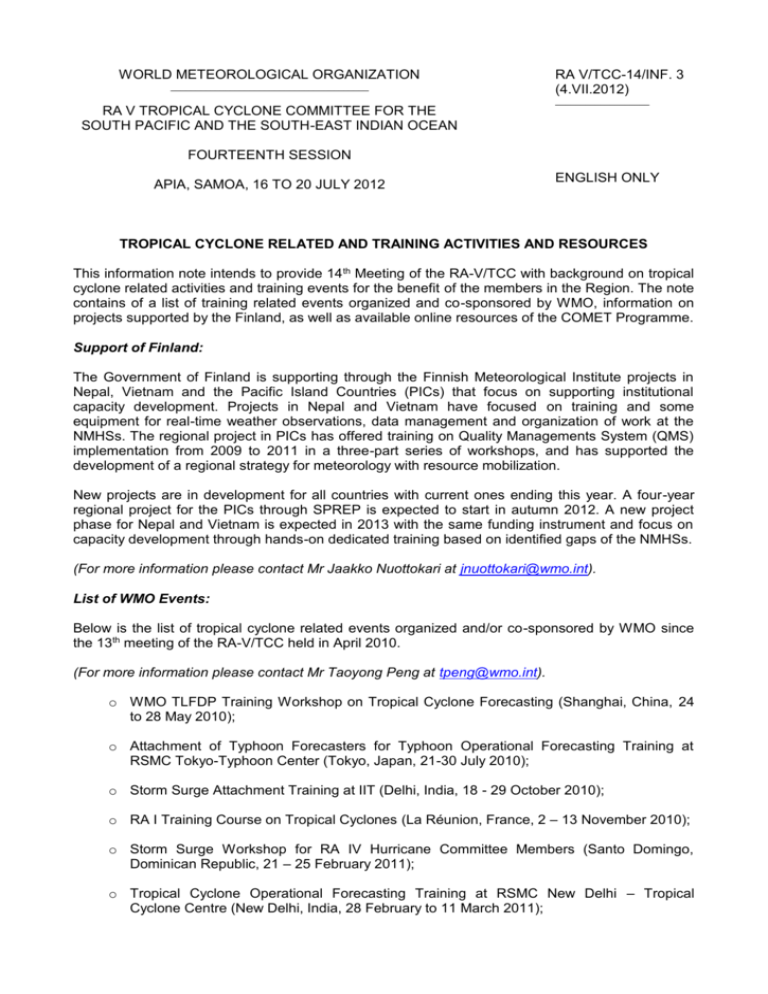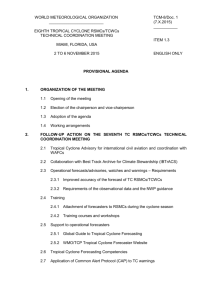INF. 3
advertisement

WORLD METEOROLOGICAL ORGANIZATION ________________________________________ RA V/TCC-14/INF. 3 (4.VII.2012) ___________________ RA V TROPICAL CYCLONE COMMITTEE FOR THE SOUTH PACIFIC AND THE SOUTH-EAST INDIAN OCEAN FOURTEENTH SESSION APIA, SAMOA, 16 TO 20 JULY 2012 ENGLISH ONLY TROPICAL CYCLONE RELATED AND TRAINING ACTIVITIES AND RESOURCES This information note intends to provide 14 th Meeting of the RA-V/TCC with background on tropical cyclone related activities and training events for the benefit of the members in the Region. The note contains of a list of training related events organized and co-sponsored by WMO, information on projects supported by the Finland, as well as available online resources of the COMET Programme. Support of Finland: The Government of Finland is supporting through the Finnish Meteorological Institute projects in Nepal, Vietnam and the Pacific Island Countries (PICs) that focus on supporting institutional capacity development. Projects in Nepal and Vietnam have focused on training and some equipment for real-time weather observations, data management and organization of work at the NMHSs. The regional project in PICs has offered training on Quality Managements System (QMS) implementation from 2009 to 2011 in a three-part series of workshops, and has supported the development of a regional strategy for meteorology with resource mobilization. New projects are in development for all countries with current ones ending this year. A four-year regional project for the PICs through SPREP is expected to start in autumn 2012. A new project phase for Nepal and Vietnam is expected in 2013 with the same funding instrument and focus on capacity development through hands-on dedicated training based on identified gaps of the NMHSs. (For more information please contact Mr Jaakko Nuottokari at jnuottokari@wmo.int). List of WMO Events: Below is the list of tropical cyclone related events organized and/or co-sponsored by WMO since the 13th meeting of the RA-V/TCC held in April 2010. (For more information please contact Mr Taoyong Peng at tpeng@wmo.int). o WMO TLFDP Training Workshop on Tropical Cyclone Forecasting (Shanghai, China, 24 to 28 May 2010); o Attachment of Typhoon Forecasters for Typhoon Operational Forecasting Training at RSMC Tokyo-Typhoon Center (Tokyo, Japan, 21-30 July 2010); o Storm Surge Attachment Training at IIT (Delhi, India, 18 - 29 October 2010); o RA I Training Course on Tropical Cyclones (La Réunion, France, 2 – 13 November 2010); o Storm Surge Workshop for RA IV Hurricane Committee Members (Santo Domingo, Dominican Republic, 21 – 25 February 2011); o Tropical Cyclone Operational Forecasting Training at RSMC New Delhi – Tropical Cyclone Centre (New Delhi, India, 28 February to 11 March 2011); RA V/TCC-14/INF. 3, p. 2 o RA IV Workshop on Hurricane Forecasting and Warning and Public Weather Services (Miami, Florida, USA, 21 March – 1 April 2011); o Attachment of Typhoon Forecasters for Typhoon Operational Forecasting Training at RSMC Tokyo-Typhoon Center (Tokyo, Japan, 20-29 July 2011); o The Ninth Southern Hemisphere Training Course on Tropical Cyclones and Training Workshop on Public Weather Services (Melbourne, Australia, 5 – 23 September 2011); o Training Workshop on Wave and Storm Surge Forecasting in RA II (Macao, China, 10 – 14 October 2011); o Training Workshop on Application of Superensemble Techniques into Typhoon Track Forecasting (Nanjing, China, 5 – 16 December 2011); o Storm Surge Attachment Training at IIT (Delhi, India, 12 to 23 December 2011); o Tropical Cyclone Operational Forecasting Training at RSMC New Delhi – Tropical Cyclone Centre (New Delhi, India, 20 February to 2 March 2012); o RA IV Workshop on Hurricane Forecasting and Warning, and Public Weather Forecast (Miami, USA, 12 – 23 March 2012); o 2nd WMO TLFDP Training Workshop on Tropical Cyclone Forecasting (Shanghai, China, 11 to 15 June 2012) The COMET Program Distance Learning Modules Introduction to Tropical Meteorology, 2nd Edition Chapter 8: Tropical Cyclones Tropical cyclones are the deadliest tropical weather systems. This chapter describes their seasonal and geographic variability and controls, decadal cycles, and history of naming conventions. Tropical cyclogenesis is explored in depth and the core and balance solutions for regions of the cyclone are examined. Intensity is considered in terms of inner-core dynamics, largescale environmental controls, limits on potential intensity, satellite interpretation techniques, and classification by wind speed. Factors that influence motion are investigated. Extratropical transition is described in terms of structural changes, preceding mechanisms, and impact on high latitudes. Societal impacts and mitigation are also covered. Topics in Tropical Meteorology This module brings together six short lessons about significant atmospheric and oceanic influences on tropical cyclone development in the Atlantic Ocean. Topics treated include the African Easterly Jet, the Loop Current, the Meridional Overturning Circulation, ocean heat content, the Saharan Air Layer, and the Tropical Upper Tropospheric Trough, or TUTT. RA V/TCC-14/INF. 3, p. 3 Microwave Remote Sensing: Clouds, Precipitation, and Water Vapor This module provides an introduction to polar-orbiting-satellitebased microwave remote sensing products that depict moisture and precipitation in the atmosphere. The module begins with definitions and descriptions of total precipitable water and cloud liquid water products, contrasting each with more familiar infrared water vapor and window channel products. This is followed by an overview of microwave precipitation estimation and a discussion of how polar-satellite products compare with those from geostationary satellites and ground-based radar. A series of case examples highlights potential weather forecasting applications for total precipitable water and precipitation products. The module also includes an introduction to the Global Precipitation Monitoring Mission to which future NPOESS satellites will be an important contributor. This module takes about 75 minutes to complete. Conceptual Models of Tropical Waves Tropical waves are prolific rainfall producers that sometimes form tropical cyclones. Conceptual models of tropical waves are used to help learners understand the dynamical characteristics and evolution of tropical waves. Users will learn about the vertical and horizontal structure of tropical waves and the typical weather changes that accompany the passage of a tropical wave. Four different methods of tracking tropical waves are also provided. The Webcast is presented by Mr. Horace Burton and Mr. Selvin Burton of the Caribbean Institute for Meteorology and Hydrology under the auspices of the MeteoForum Project. Advances in Microwave Remote Sensing: Ocean Wind Speed and Direction This Webcast covers the ocean surface wind retrieval process, the basics of microwave polarization as it relates to wind retrievals, and several operational examples. Information on the development of microwave sensors used to retrieve ocean surface wind speed and the ocean surface wind vector (speed and direction) is also included. Polar Satellite Products for the Operational Forecaster: Microwave Analysis of Tropical Cyclones This module introduces forecasters to the use of microwave image products for observing and analyzing tropical cyclones. Microwave data from polar-orbiting satellites is crucial to today’s operational forecasters, and particularly for those with maritime forecasting responsibilities where in situ observations are sparse. This module includes information on storm structure and techniques for improved storm positioning using the 37 and 85-91 GHz channels from several satellite sensors. Information on current sensors and on the product availability in the NPOESS era is also presented. RA V/TCC-14/INF. 3, p. 4 Community Hurricane Preparedness, 2nd Edition The purpose of this course is to provide emergency managers who face threats from tropical cyclones and hurricanes with basic information about: How tropical cyclones form The hazards they pose How the NWS forecasts future hurricane behavior What tools and guiding principles can help emergency managers prepare their communities It will provide a good background for those who either plan to attend those courses or cannot attend them. The original module was published in 2000. This 2nd edition provides updated information on hurricane science and National Weather Service forecast products. In addition, a new section on Emergency Management discusses decision-making tools that can help emergency managers in response and evacuation decision-making during hurricane threats. Hurricane Strike!™ Designed primarily for middle school students and funded by FEMA and the NWS, this module creates a scenario to frame learning activities that focus on hurricane science and safety. Versions are also available for hearing, motor, and visually impaired students, as well as Spanish-speaking students. Over the course of seven days, Hurricane Erin forms in the Atlantic Ocean, crosses the Florida peninsula, and then makes another landfall at Fort Walton Beach. During these days, the learner is introduced to many basic concepts of atmospheric science, climate, and geography, while also learning some important and possibly life-saving safety and preparedness skills. The module includes several interactive games and activities that address hurricane meteorology and hurricane safety. Teachers and others who use the module for public education will find the "Information for Teachers" section particularly useful. This section provides information about all of the main learning objects in the module, as well as access to them as stand-alone activities. Links to numerous hurricane-related Web sites are also included, as are links to expert advice about helping children deal with trauma. Worksheets that test the learner's understanding of the module's content are provided in this section. Students access a different worksheet each day on the "printer" in the scenario's home office. Remote Sensing of Ocean Wind Speed and Direction: An Introduction to Scatterometry This Webcast features Dr. Michael Freilich (Oregon State University, principal investigator on the QuikSCAT project for NSF) introducing and discussing the fundamentals of scatterometry and how they apply to the SeaWinds instrument on QuikSCAT. Dr. Freilich also describes how the model function is used to derive wind speed and direction from multiple collocated measurements. RA V/TCC-14/INF. 3, p. 5 Hurricanes Canadian Style: Extratropical Transition This Webcast is based on a presentation delivered by Jim Abraham of MSC at the Winter Weather Course in February 2001. The presentation discusses how, under the right synoptic conditions, hurricanes and tropical storms undergo a transition process to extratropical cyclones as they move into northern latitudes. During the transition process these "hybrid" systems can bring damaging weather conditions to Eastern Canada and the Northeastern States. It uses several case examples to demonstrate the process. Anticipating Hazardous Weather and Community Risk, 2nd Edition Anticipating Hazardous Weather and Community Risk, 2nd Edition provides emergency managers and other decision makers with background information about weather, natural hazards, and preparedness. Additional topics include risk communication, human behavior, and effective warning partnerships, as well as a desktop exercise allowing the learner to practice the types of decisions required as hazardous situations unfold. This module offers web-based content designed to address topics covered in the multi-day Hazardous Weather and Flood Preparedness course offered by the Federal Emergency Management Agency (FEMA) and the National Weather Service (NWS). The module also complements other onsite courses by those agencies and provides useful information for evaluating and preparing for threats from a range of weather and natural hazards. _____







